FEATURES|COLUMNS|Ancient Dances
Dance at Dunhuang: Part Two – The Case for the Feitian
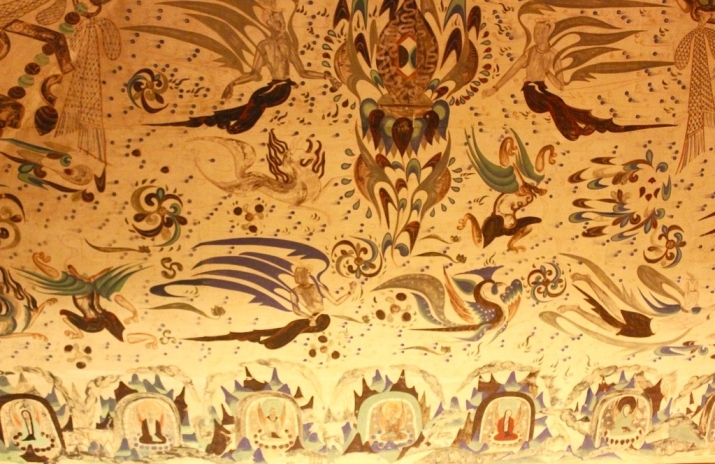 Feitian (“sky spirits”) on a ceiling wall along with mythological creatures and archaic deities, Mogao Cave 285, Dunhuang. Western Wei dynasty (535–57), mural painting. Image courtesy of the Dunhuang Academy. From Core of Culture
Feitian (“sky spirits”) on a ceiling wall along with mythological creatures and archaic deities, Mogao Cave 285, Dunhuang. Western Wei dynasty (535–57), mural painting. Image courtesy of the Dunhuang Academy. From Core of CultureMore dance styles are depicted in the Dunhuang Mogao Grottoes than at any other archaeological site on earth. Dance imagery animates nearly every cave. The wall paintings—a veritable encyclopedia of movement traditions spanning eight centuries—convey a native Chinese genius for dance that absorbed influences and choreography from bordering Central Asian cultures as well as from cultures far away. The Great Wall of China kept people out; Dunhuang let people in. This stream of growing cosmopolitanism matched the spread of Buddhism.
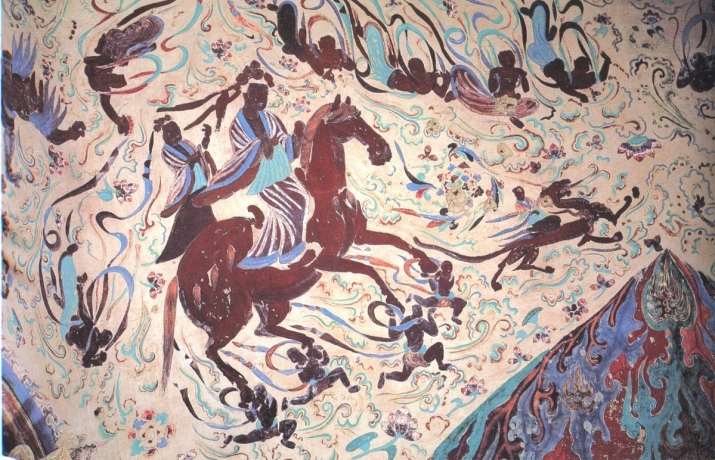 Siddhartha crossing over the palace wall at night, with feitian, mythological creatures, and archaic deities, Mogao Cave 329, Dunhuang. Early Tang dynasty (618–704), mural painting. Image courtesy of the Dunhuang Academy. From Core of Culture
Siddhartha crossing over the palace wall at night, with feitian, mythological creatures, and archaic deities, Mogao Cave 329, Dunhuang. Early Tang dynasty (618–704), mural painting. Image courtesy of the Dunhuang Academy. From Core of CultureDance has its own history and evolution within the growth of Buddhism, and the cave paintings at the Mogao Grottoes provide more details to complement what any official dance history could provide. Like martial arts and meditation, dance is a transmitted art, person to person, and has its own way of remembering. Music, dance, meditation, martial arts, and ritual etiquette are all intended in the classical Chinese sense of a movement tradition. The great records of ancient Chinese dance are called “Books of Music.” Many depicted dancers in caves surrounding Dunhuang are playing instruments.
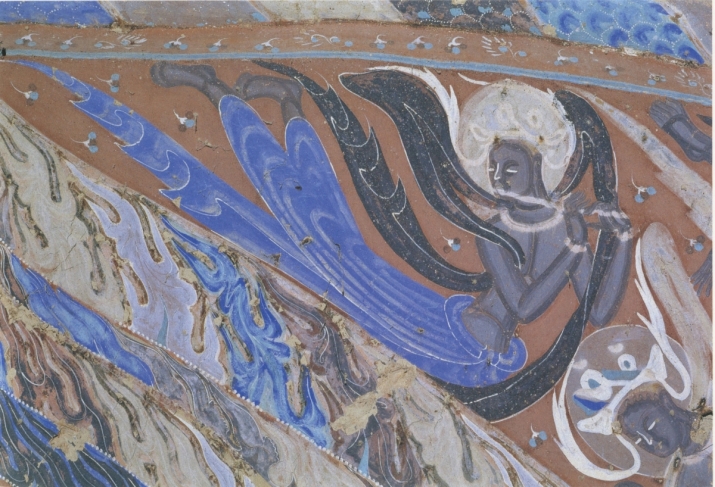 Feitian playing a flute, Mogao Cave 249, Dunhuang. Western Wei dynasty (535–57), mural painting. Image courtesy of Wang Kefen. After The Complete Collection of Dunhuang Grottoes, Vol. 17, Paintings of Dance, The Commercial Press, Hong Kong, 2001, p. 15
Feitian playing a flute, Mogao Cave 249, Dunhuang. Western Wei dynasty (535–57), mural painting. Image courtesy of Wang Kefen. After The Complete Collection of Dunhuang Grottoes, Vol. 17, Paintings of Dance, The Commercial Press, Hong Kong, 2001, p. 15It helps to forgo some of our habitual understandings of what dance is, and does, in order to see how it functions in Buddhism, for that itself absorbed and involved a range of very different ideas. The Dunhuang grottoes are a Rosetta Stone of ancient dances, dance being the oldest language, the pre-language. Since most Central Asian cultures had no written language until the 7th century, Dunhuang’s depictions of performing arts from distant areas are invaluable for cultural understanding. The painted murals portray real clothes, weapons, and instruments, and the dances, too, are taken from life. It has been suggested that the dancer paintings were modeled on the patrons’ own dancers. Many actual historical incidents are recorded in the murals and also many religious stories such as the Jataka Tales, the Life of the Buddha, and those told in the Buddhist sutras.
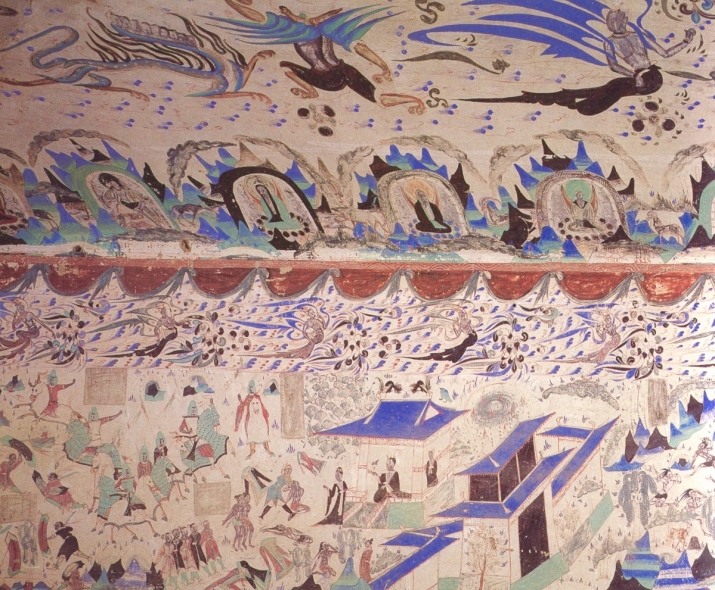 Story of the 500 bandits who converted to Buddhism, Mogao Cave 285, Dunhuang, with large feitian and archaic deities at the top, monks meditating in caves in the mountains, smaller feitian flying above the spiritual event, and the story itself at the bottom. Western Wei dynasty (535–57), mural painting. Image courtesy of the Dunhuang Academy. From Core of Culture
Story of the 500 bandits who converted to Buddhism, Mogao Cave 285, Dunhuang, with large feitian and archaic deities at the top, monks meditating in caves in the mountains, smaller feitian flying above the spiritual event, and the story itself at the bottom. Western Wei dynasty (535–57), mural painting. Image courtesy of the Dunhuang Academy. From Core of CultureThe spread of Buddhism along the Silk Road into China, from the days Dunhuang became a Han dynasty (206 BCE–220 CE) garrison town after Emperor Wu’s (r. 141–87 BCE) expedition to the western regions in 118 BCE, to its flowering as a center of the refined, exotic culture of the Tang dynasty (618–907) centuries later, has left the world a touchstone of one of the most diverse cultural exchanges in world history; a period when Buddhism and cosmopolitanism grew together. Depictions of dance in the caves around Dunhuang are an unbroken, if overlooked, chronicle of this.
The Tang capital, Chang’an, was the largest, most cosmopolitan city in the world at the time. It was peopled by traders, entertainers, and religious practitioners, both lay and ordained, from places as far-flung as Syria, Oman, Iran, Japan, Korea, Sogdiana, Khotan, Tibet, Turkestan, Champa, India, and yet more. Religions coexisted and inspired one another. There were Muslims, Jews, Manicheans, Zoroastrians, and Nestorian Christians. Daoism, the indigenous religion of China, was always practiced and respected.
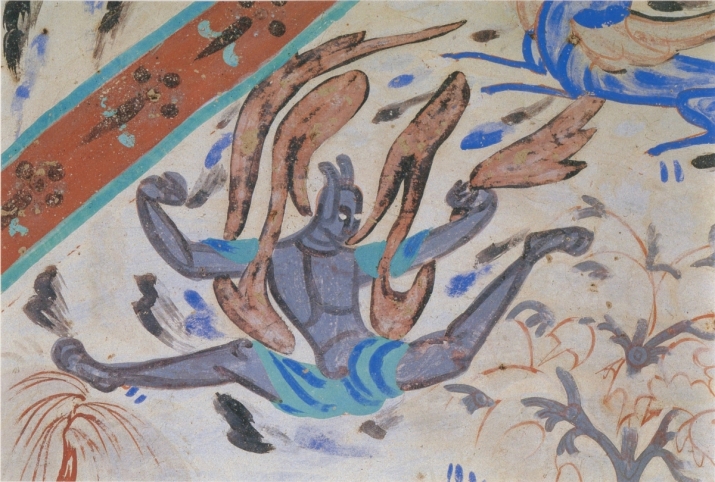 Ceiling showing the archaic deity servant of the King of the East, Mogao Cave 249, Dunhuang. Western Wei dynasty (535–57), mural painting. Image courtesy of Wang Kefen. After The Complete Collection of Dunhuang Grottoes, Vol. 17, Paintings of Dance, The Commercial Press, Hong Kong, 2001, p. 16
Ceiling showing the archaic deity servant of the King of the East, Mogao Cave 249, Dunhuang. Western Wei dynasty (535–57), mural painting. Image courtesy of Wang Kefen. After The Complete Collection of Dunhuang Grottoes, Vol. 17, Paintings of Dance, The Commercial Press, Hong Kong, 2001, p. 16There were as well many Buddhist monasteries of all schools, some of which were great centers of scholarship; some were Theravada Buddhist, whose puritanical practices rejected dance as suitable activity for monks, while in others the monks themselves danced with perfect canonical propriety. Because Theravada Buddhist monks did not dance, it was left to lay people and developed as an offering akin to incense and flowers, and so the sky was the limit as to how exotic these dances could be. To this day, Buddhist Kandyan dancers from Sri Lanka do back flips in the air as part of their rhythmic approach to the altar. The dances depicted in the Dunhuang caves reflect the various forms of Buddhism.
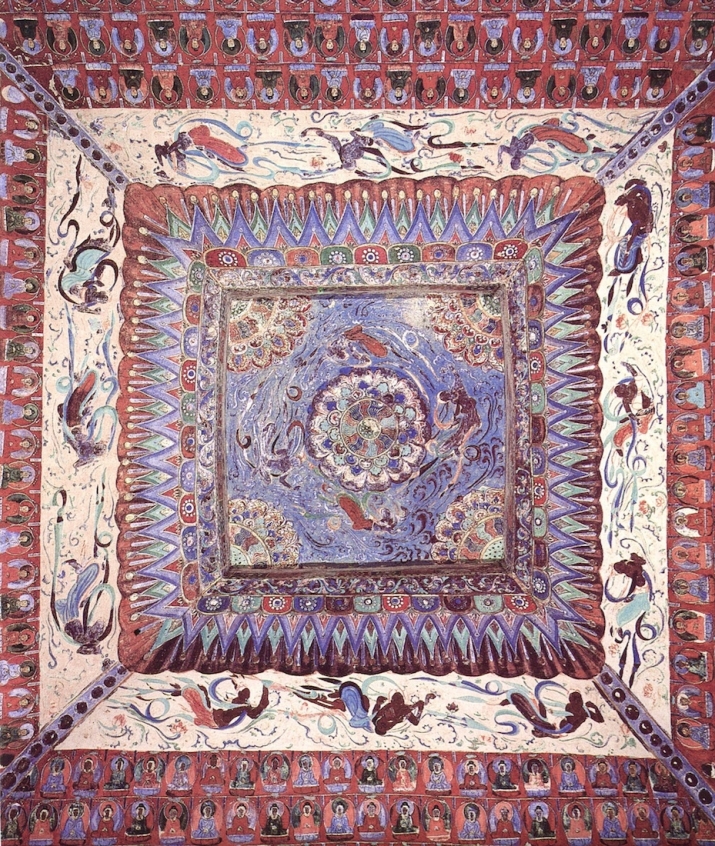 Pyramidal ceiling, Mogao Cave 329, Dunhuang. From the outside edges of “thousand buddhas” pattern moving inward and upward: feitian flying, holding offerings, and playing instruments; Central Asian motif pattern; feitian enciricling a mandala of highest heaven. Early Tang dynasty (618–704), mural painting. After Fan Jinshi and Zhao Shenglian, The Art of the Mogao Grottoes, Homa and Sekey Books, Princeton, NJ, 2004, p. 157
Pyramidal ceiling, Mogao Cave 329, Dunhuang. From the outside edges of “thousand buddhas” pattern moving inward and upward: feitian flying, holding offerings, and playing instruments; Central Asian motif pattern; feitian enciricling a mandala of highest heaven. Early Tang dynasty (618–704), mural painting. After Fan Jinshi and Zhao Shenglian, The Art of the Mogao Grottoes, Homa and Sekey Books, Princeton, NJ, 2004, p. 157The making of the caves and the styles of the early art depicted in them came from the Silk Road, originating in the Kushan Empire wherein Greco-Roman influence met Persian, Afghan, and Central Asian motifs. This included oasis kingdoms like Khotan, Turfan, and other cities where Buddhist monuments and painted caves existed. This was a meeting of styles and customs, where the Silk Road and Chinese cultures came together to produce the syncretic style unique to the caves around Dunhuang.
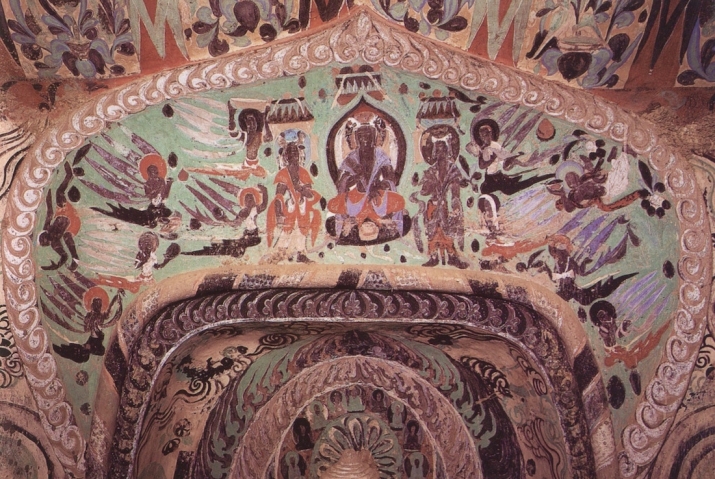 Lintel of a sculptural niche on the south face of square central pillar, Mogao Cave 7, Dunhuang, showing Buddha flanked by two kings, with feitian flying, holding offerings, and playing music. Tang dynasty, 628, mural painting. Image courtesy of the Dunhuang Research Academy. From Core of Culture
Lintel of a sculptural niche on the south face of square central pillar, Mogao Cave 7, Dunhuang, showing Buddha flanked by two kings, with feitian flying, holding offerings, and playing music. Tang dynasty, 628, mural painting. Image courtesy of the Dunhuang Research Academy. From Core of CultureOne compelling, and often seemingly otherworldly, being that is depicted in the Buddhist murals throughout the 800 years is the feitian (in Chinese), or “sky spirit.” The feitian does not seem to come from the western regions, but makes its appearance at Dunhuang early on. The world expert in Dunhuang dance depictions, Mme Wang Kefen, has determined that feitian are Chinese in origin and are not apsara (Sanskrit), as feitian is usually translated into English. In fact, the Dunhuang Academy has adopted the use of apsara, and so here I humbly make a case for the feitian being its own being and representative of a spiritual dimension between levels of existence. The feitian may in fact be a symbol of Buddhism’s ability to absorb the ancient religions it encountered rather than annihilating them. I agree with Mme Wang and add my thoughts here. Apsara is in general use as a catch-all term.
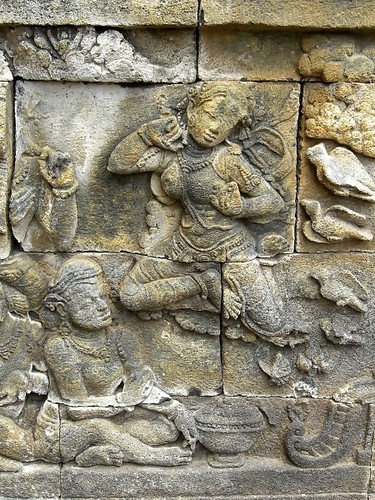
Apsara taking flight, Borobudur Temple, Java, Indonesia. 9th
century, stone. Creative commons license
It may be the case that the feitian slowly evolved into more apsara-like beings by the time of the Tang dynasty. Apsara are beautiful flying women, known to seduce; they are associated with watery things: ocean, rain, clouds. Apsara derive from Hinduism and Theravada Buddhist cultures. These were cultures, such as in Cambodia, Burma, Ceylon, and Siam, where kings kept large groups of dancing girls—one king was reputed to have had 30,000. As Buddhism came to be the adopted religion of these places, it was easy enough for the court dancing girls to wear small wings and instantly become heavenly maidens, retaining all their sex appeal and coy ways. This could not be farther from the expression of dance performed by ordained monk-dancers. Apsara are derived from these dancing girls.
Feitian, by contrast, are of both sexes, and are not as interested in this world as being a bridge to another one. Their aesthetic evolution over many centuries is a study in freedom, beauty, and power. This topic allows me to share a number of amazing images of feitian from the Mogao Caves. Their origin is murky Chinese ancient belief, and their movements are related to ancient forms of mythology, dance, exercise, and breath control. We can see, in a Han dynasty casket of a nobleman unearthed at Mawangdui in 1972, swirling patterns and gravity-defying deities cavorting within them, dancing, fighting, running. These Han figures are strikingly similar to feitian. Feitian come from archaic Chinese movement traditions.
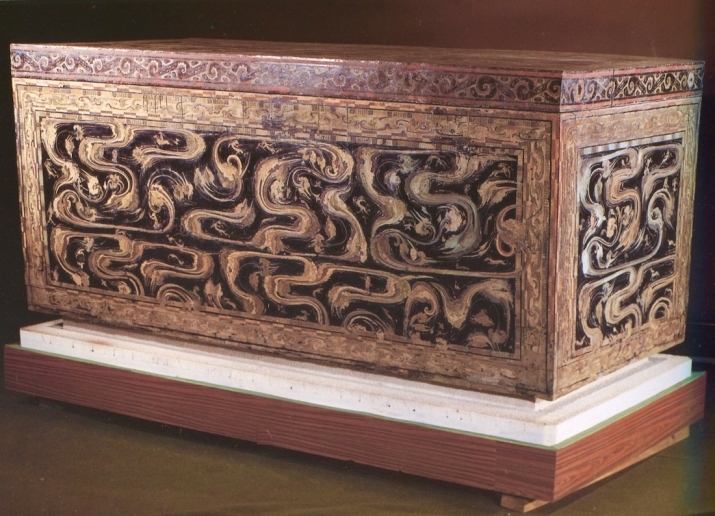 Nobleman’s casket, showing archaic Daoist deities cavorting in a primordial swirling pattern. Excavated in 1972 from Mawangdui, Changsha, Hunan Province. Western Han dynasty (206 BCE–220 CE). After Fu Juyou, Cheng Songchang (Zhou Shiyi, Chen Kefeng, trans.), The Cultural Relics Unearthed from the Han Tombs at Mawangdui, Hunan Publishing House, Changsha, Hunan Province, 1980, p. 6
Nobleman’s casket, showing archaic Daoist deities cavorting in a primordial swirling pattern. Excavated in 1972 from Mawangdui, Changsha, Hunan Province. Western Han dynasty (206 BCE–220 CE). After Fu Juyou, Cheng Songchang (Zhou Shiyi, Chen Kefeng, trans.), The Cultural Relics Unearthed from the Han Tombs at Mawangdui, Hunan Publishing House, Changsha, Hunan Province, 1980, p. 6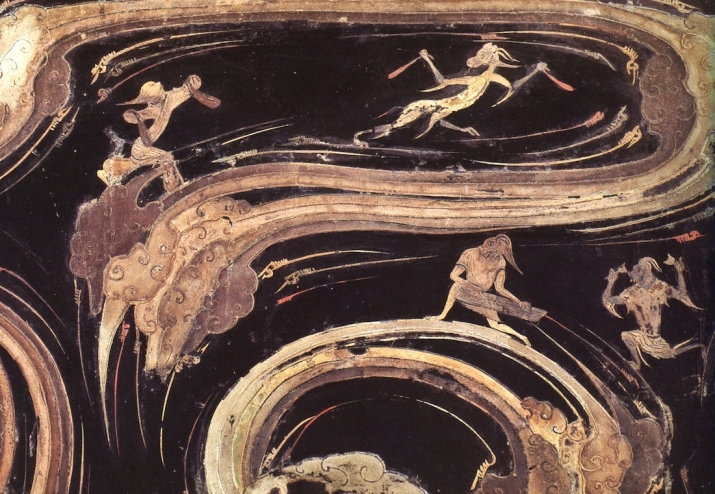 Detail of casket from Mawangdui showing archaic Daoist deities and mythological creatures dancing, playing music, fighting, and frolicing. After Fu Juyou, Cheng Songchang (Zhou Shiyi, Chen Kefeng, trans.), The Cultural Relics Unearthed from the Han Tombs at Mawangdui, Hunan Publishing House, Changsha, Hunan Province, 1980, p. 10
Detail of casket from Mawangdui showing archaic Daoist deities and mythological creatures dancing, playing music, fighting, and frolicing. After Fu Juyou, Cheng Songchang (Zhou Shiyi, Chen Kefeng, trans.), The Cultural Relics Unearthed from the Han Tombs at Mawangdui, Hunan Publishing House, Changsha, Hunan Province, 1980, p. 10Feitian serve many functions, for all their mystery. They are the nameless “Greek chorus” to nearly every event. Their ability to move their bodies in acrobatic ways allows them to be ideal for design development: they can be made to fit in any space. Being always seen with billowing silk, Chinese dance historians look to feitian for evidence of the development of their ancient silk scarf dance. The Chinese invented the production of silk.
In Dunhuang art, feitian inhabit their own level of reality, making a distinct division between other areas of the mural: they are at the top, in the air, in images where hierarchies of divine beings are presented surrounding a central Buddha. They are not the bodhisattvas attending the Buddha, nor are they the humans often seen at the bottom, on the earth. Feitian symbolize the most rarefied level of being. They are often seen painted among archaic Daoist deities, such as the similar-looking gods of thunder and lightning. They come in different sizes even in the same mural. Some feitian appear as archaic deities themselves.
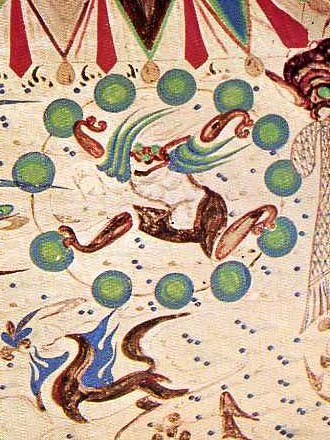
Pyramidal ceiling wall showing archaic god of
thunder and mythological beast, Mogao Cave 249,
Dunhuang. Western Wei dynasty (535–57), mural
painting. Image courtesy of Wang Kefen. From Core
of Culture
Nothing dances or moves like a feitian. They can do anything. At times their aerial behavior is reminiscent of Giotto’s expressive angels. At other times they seem indifferent, symbols of a level of being untouched by human emotions and worldly powers like gravity, silent reminders that there is a larger reality at play.
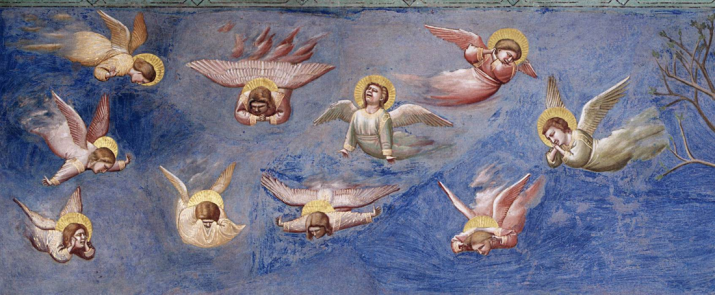 The Mourning of Christ, detail from Scenes from the Life of Christ by Giotto (1266/7–1337), Scrovegni Chapel, Padua, Italy, showing angels lamenting in the sky. 1304–6, fresco painting. From www.wga.hu
The Mourning of Christ, detail from Scenes from the Life of Christ by Giotto (1266/7–1337), Scrovegni Chapel, Padua, Italy, showing angels lamenting in the sky. 1304–6, fresco painting. From www.wga.huMost significant, though, is where the feitian are placed architecturally. They serve as quantum dividers: a border between historical events and sublime higher realities. Or again, they appear as the personification of the highest reality, swirling above the central Buddha in an ascending pyramidal ceiling, distinct from the behavior and understanding of the humans below.
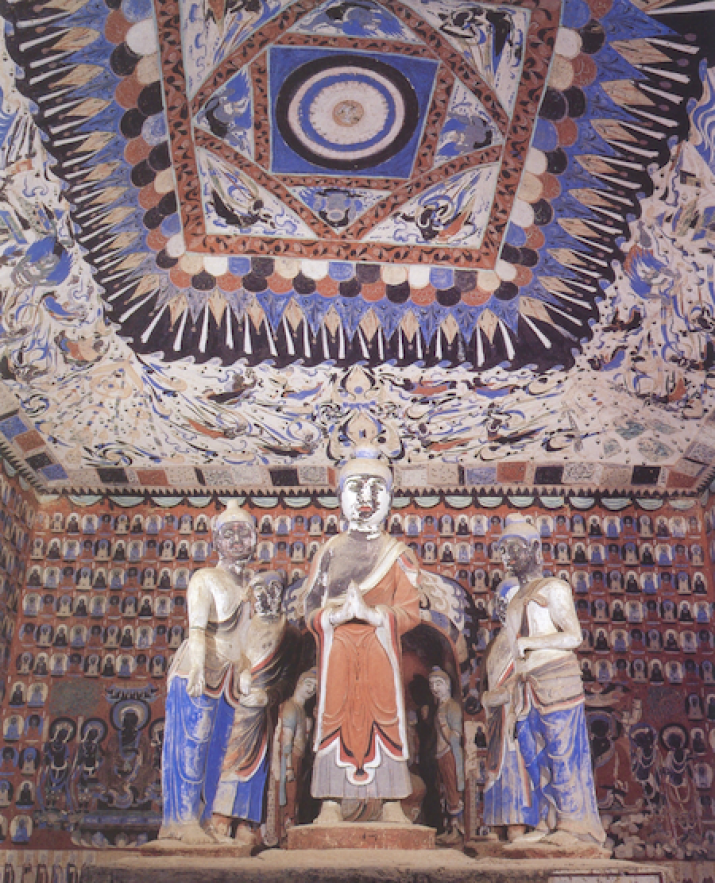 Buddha and bodhisattvas in front of a “thousand Buddhas” patterned mural, above which is a pyramidal ceiling with flying feitian and patterned design, inside which are more feitian dancing around a central mandala, Mogao Cave 305, Dunhuang. Sui dynasty (581–618). Image courtesy of the Dunhuang Research Academy. From Core of Culture
Buddha and bodhisattvas in front of a “thousand Buddhas” patterned mural, above which is a pyramidal ceiling with flying feitian and patterned design, inside which are more feitian dancing around a central mandala, Mogao Cave 305, Dunhuang. Sui dynasty (581–618). Image courtesy of the Dunhuang Research Academy. From Core of CultureThe cave murals depict activities occurring within them, such as monks meditating in hewn-out cubicles. The first small caves at Mogao were for monks in meditation. Later, assembly caves were made, enabling rituals and teaching and circumambulation to take place. Walls covered with the “thousand buddhas” design are thought by some to be visual representations of the repeated chanting of sutras and mantras.
A teacher could tell a story by referring to a mural. A monk could lead a sutra recitation by following the patterns on the wall. In Buddhist caves, among historical stories, religious stories, human devotional practices, and abodes of the Buddha, this is where the divine acrobats, the sky dancing warriors, the heavenly musicians, the feitian, are found, where they soar in their own distinct dimension.
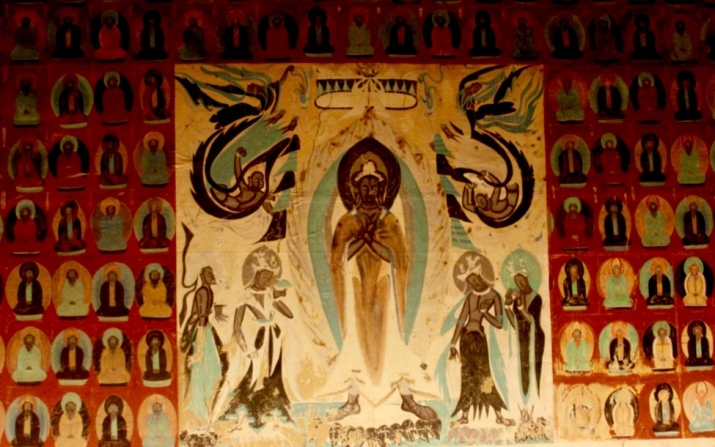 Buddha and bodhisattvas, with feitian flying in the sky above, set within “thousand Buddhas” design, Mogao Cave 249, Dunhuang. Western Wei dynasty (535–57), mural painting. Photo by Clarkson Lee. Used with permission
Buddha and bodhisattvas, with feitian flying in the sky above, set within “thousand Buddhas” design, Mogao Cave 249, Dunhuang. Western Wei dynasty (535–57), mural painting. Photo by Clarkson Lee. Used with permissionRelated features from Buddhistdoor Global
Dance at Dunhuang: Part One
Dance at Dunhuang: Part Three - The Sogdian Whirl














